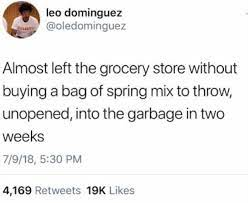Household Food Waste: That Chard You Didn’t Quite Get To
Most of us are familiar with food waste. But did you know there’s also a significant climate impact?
It strikes every week or two when the leftovers and unused veggies start to pile up like a squishy fortress in the back of the fridge. It makes so much sense when we pick up that gorgeous chard at the farmer’s market! We have big plans for it! We will make a meal like no other! But all too often, we rediscover said chard as an unrecognizable, nasty mess in a bag on the bottom shelf after waiting too long to cook it up for dinner. What a waste.
The pervasiveness of this experience is evident in viral social media posts that satirize this chronic behavior, proclaiming: “Almost left the grocery store without buying a bag of spring mix to throw, unopened, into the garbage in two weeks” (@oledominguez on Twitter).

It seems so innocent from week to week but, all of that convenience and subsequent waste comes at a significant cost to the climate. The EPA estimates that each year, U.S. food loss and waste is responsible for 170 million metric tons of carbon dioxide equivalent (million MTCO2e) GHG emissions – the same as the annual CO2 emissions of 42 coal-fired power plants. And the USDA’s Economic Research Service estimates that 31 percent of food loss occurs at the retail and consumer levels, adding up to approximately 133 billion pounds and $161 billion in food costs.
That’s you and me and that chard. Ugh.
The Natural Resources Defense Council created a fantastic campaign to raise awareness about this very issue, documenting the life of a strawberry from farm to fridge, and potentially to your garbage can.
According to the EPA report From Farm to Kitchen: The Environmental Impacts of U.S. Food Waste, food loss and waste accounts for 2 percent of total U.S. energy consumption and uses enough energy to power approximately 56 million U.S. homes for a year. The consumption stage of the supply chain accounts for 72 percent of wasted energy from food loss & waste, with household waste exceeding that created away-from-home. The impacts even expand beyond energy consumption to include agricultural land use, water consumption, fertilizer production and more.
Perhaps, most jarringly, the same EPA report cited multiple studies that demonstrate inedible food accounted for approximately 30 percent of total household food waste, by weight, meaning;
About 70% of wasted food is edible.
Clearly, there is a lot to do when it comes to reducing household food waste, but the strategies to be more efficient with the food we buy often evade us. The EPA identified the greatest opportunity for reducing the impact of food waste would be to cut food loss and waste in households, restaurants, and the food processing sector in half – a daunting but not impossible feat.
Food Waste Part Deux will dig into some of the solutions for reducing household food waste and how you can personally shift the impact of what’s (still) sitting in your fridge.
By Kendall Glauber, Recyclability Solutions Director at The Recycling Partnership and benefyd advisor


